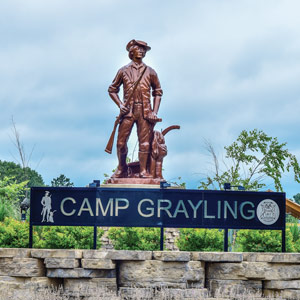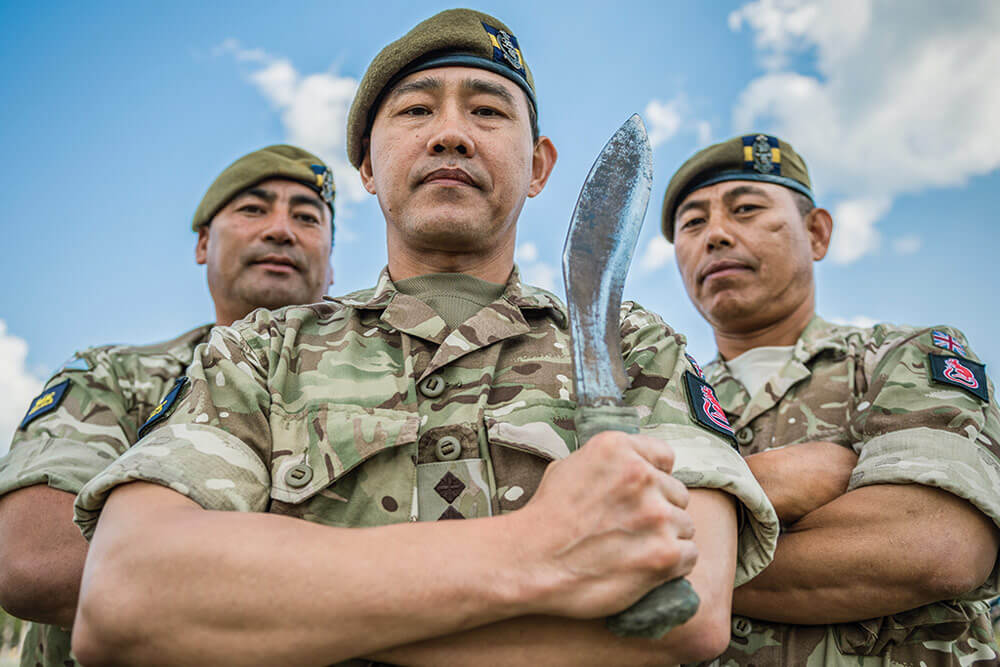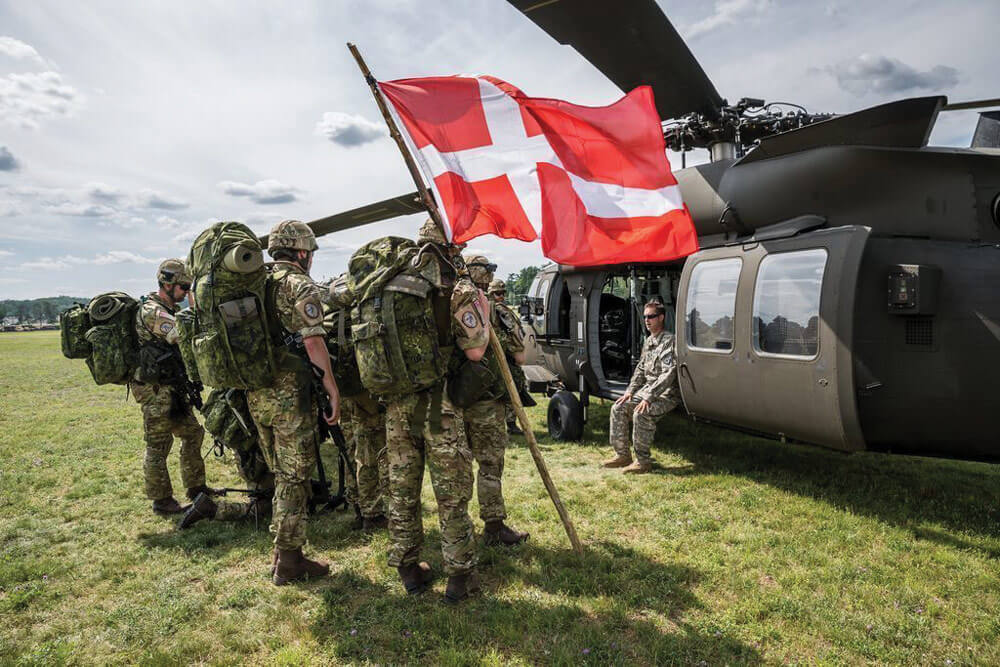This summer more than 7,000 military personnel descended upon Michigan’s Camp Grayling Joint Maneuver Training Center for Operation Northern Strike (ONS) 2017.
ONS, an annual joint multinational exercise, brought Soldiers of various branches and nations to the largest National Guard training facility in the country. The two-week exercise provides readiness-building opportunities that emphasize cohesion between branches of service.

ONS has gained notoriety for its remarkably accurate training environment. It is one of only 43 programs worldwide to gain Joint National Training Capacity accreditation and is the only exercise managed by the National Guard that coordinates both ground and air assets, according to the Joint Force Headquarters, Michigan National Guard. The objective of ONS is to provide accessible, readiness-building opportunities for units of all service branches to achieve or sustain proficiency in conducting mission command; air, sea, and ground maneuver integration; and the synchronization of fires in a joint, multinational, decisive action and major combat operations environment that is scalable to unit resource levels.
“The Army, the Marines, the Navy – to get them synchronized at the right place on the battlefield at the right time to decisively win is what this exercise is all about,”
-MG Greg Vadnais
“Today’s warriors go to battle with companions from other countries and other branches of service,” said LTC Dawn Dancer, Public Affairs Officer with the Michigan National Guard. “We are all going in together, interwoven – not side-by-side or in separate lanes. Those co-warriors fly overhead and fire adjacent [to] each other’s battlefield locations all while speaking another language and using unfamiliar acronyms. The time to learn their acronyms and flight patterns is not the day you set foot on the battlefield. The Northern Strike exercise, by design, trains in exactly this scenario.”
ONS, hosted by the Michigan National Guard, was developed in 2012 as an Air National Guard exercise. The goal was to prepare Air National Guard units for employment with an air expeditionary wing within a deployed wing construct or into a brigade combat team.

In the first year approximately 500 participants engaged. After six exercise cycles, ONS has grown exponentially. Now a joint initiative sponsored by the National Guard Bureau, ONS 2017 included 7,500 participants and, according to the Northern Strike public affairs office, is
the most complex reserve component-led training exercise in the United States.
The current focus of ONS is training for decisive actions in combined arms live fire situations emphasizing close air support, joint fire support and coordinated maneuvers with fires and air mobility – including command, control, communications, computers and intelligence elements of theater air ground system. During the exercise, each branch of the military followed a mock scenario involving simulated city attacks and air-to-ground combat.

The training helps Soldiers improve their existing skills, thus enhancing their ability to protect States and nations and work under allied partnerships. LTC Ray Stemitz, Operations Officer for the Michigan Guard noted the importance of this type of training.
“It is very unique for Soldiers to gain this type of experience before getting to theater,” LTC Stemitz said:
“This exercise helps to build our readiness and keep it sharp. [ONS] ensures we deliver a very transparent experience to the Soldiers.”
This year, ONS participants included Soldiers from 62 Army, Marine, Air Force, Special Forces and multi-national units. International partners included Canada, Great Britain, Denmark, Latvia and Poland.
Planning an event on the scale of ONS is a huge undertaking. ONS 2017 was in the planning stages in 2016, with some coordination beginning as early as five years prior. According to TSgt. Richard Boyer, Joint Terminal Attack Controller (JTAC) instructor and lead planner, coordinating a multitude of aircraft, JTACs, and OPFOR [Opposing Forces] proved challenging at times.
“The most difficult part is the execution piece,” said TSgt Boyer. “Because there are so many moving pieces and such a large area, it takes a lot of coordination and planning to finalize the JTAC plan, coordinate with aircraft on station and the OPFOR on the ground and making sure they are all in the right locations.”

MG Gregory J. Vadnais, the Adjutant General of the Michigan National Guard, said synchronization was key. “The Army, the Marines, the Navy – to get them synchronized at the right place on the battlefield at the right time to decisively win is what this exercise is all about,” he explained.
Training at a facility like Camp Grayling is a unique opportunity. Each year, Camp Grayling provides training for over 10,000 military personnel from National Guard units in Michigan, Indiana, Illinois and Ohio. The installation is equipped with maritime capabilities that include locations for dive operations and amphibious assault. Two of Camp Grayling’s major training areas utilized during ONS were the Virtual Battle Simulation (VBS) and the Combined Arms Collective Training Facility (CACTF). The VBS can virtually place Soldiers anywhere in the world. It can also simulate situations like a HMMWV rollover. The CACTF is designed to replicate an urban environment with buildings, streets and other terrain to place Soldiers in realistic scenarios that closely mimic what they might encounter while deployed.
“[ONS] gives us a great opportunity to work out the bugs and come up with processes to step right into theater, so it won’t be foreign when we’re on the ground.”
-LTC Craig Norton
At the CACTF, Army National Guard Soldiers partnered with combined elements from Great Britain, Latvia and Poland to train in company defense tactics during a fictional scenario securing a city from attack by enemy forces.
“Being able to actually get controls in a live environment that has aircraft and terrain very similar to Afghanistan is important,” said TSgt Boyer. “You have the team working together, so we almost want them to make mistakes here because this is where they learn so, when actual live ordnance is being dropped, they can bring their A-game.”

In addition to the high-tech training equipment available at Camp Grayling year-round, the Michigan National Guard coordinated the inclusion of a very special piece of equipment specifically for ONS 2017. This year, the exercise featured the E-8C Joint Surveillance Target Attack Radar System, known as Joint STARS, an advanced ground-surveillance and battle-management system.
The E-8C Joint STARS is a modified Boeing 707. It provides simultaneous wide-area joint airborne command and control, intelligence, surveillance and reconnaissance support over land and water from a manned platform to combatant commanders around the globe. Joint STARS is equipped with 22 radios, seven data links, two internets and secure telephone capability. The aircraft requires 21 personnel members for full operation. The joint total-force integration unit operates the world’s only Joint STARS weapon system, based out of Robins Air Force Base, Ga. The team consists of Georgia Air National Guard’s 116th Air Control Wing, the active-duty 461st Air Control Wing, and Army Joint STARS personnel. During ONS 2017, Joint STARS provided battle-management command and control as well as intelligence, surveillance and reconnaissance data.

The realistic training scenarios during Northern Strike 2017 presented the Joint STARS team with “abundant opportunities to hone our wartime capabilities while incorporating our joint and multinational partners,” said Air Force Lt Col Kenneth Billings, mission crew commander with the 116th Air Control Wing’s 128th Airborne Command and Control Squadron.
Training at ONS also included live fire scenarios ranging from enemy snipers to convoys to multiple launch rocket systems to high-mobility artillery rocket systems. In fictional scenarios Marine Reserve, Army National Guard and infantry units from Denmark, Latvia and Poland provided area security or conducted platoon attacks.
“We only have one live fire training in Arizona,” said SPC Adolfo Melendez of the Mortar Platoon, 1st Battalion, 158th Infantry Regiment, Arizona National Guard. “It’s great to be here to get training we need on such a large scale.”

In an air-training scenario, two active duty MH-60S Seahawk Naval Helicopters from the USS John C. Stennis aircraft carrier, departed Michigan Air National Guard’s Alpena Combat Readiness Training Center en route to Camp Grayling on a fictional search and rescue mission. A flight pattern with rising and falling terrain was chosen to challenge pilots.
“A wounded aviator laid in deep grass behind enemy lines, unable to move,” said LTC Dancer, explaining the scenario. “Four A-10 Thunderbolt II jet aircraft, from the 107th Fighter Squadron flew in and encircled the opposition-held area to provide overwatch and safely guide in the Seahawks. One medevac chopper landed near the wounded aviator while the other hovered close by to provide security. The medical team quickly exited the aircraft, recovered the wounded and gently brought him on board.”
“It is an honor to host freedom defenders from every branch of service and to exchange best practice experiences with our global allies.”
-MG Greg Vadnais
Collaborating with military members of multiple service branches and countries is a pivotal component of creating a realistic training experience for Soldiers. LTC Craig Norton, battalion commander of 1st Battalion, 158th Infantry Regiment, Arizona National Guard, stated that while his troops usually train alone, in an actual conflict “you would have these additional contributors in the fight.”

LTC Norton explained, “Typically speaking, we don’t have all these pieces of the pie together until we get there. [ONS] gives us a great opportunity to work out the bugs and come up with processes to step right into theater, so it won’t be foreign when we’re on the ground.”
The inclusion of international forces is a key component of ONS. It not only aids in providing a realistic training environment, for both U.S. and allied troops, this year it also served as an opportunity to strengthen some National Guard State partnerships. The California National Guard’s State partner, Nigeria, attended ONS for the first time. It was a unique opportunity for the Nigerian soldiers to witness their U.S. partner Soldiers in a live mission environment. “The Nigerian soldiers with us are engineers,” said MAJ Chiddy Adighije of the Office of Security Cooperation, U.S. Embassy Abuja, Nigeria. “We are escorting them throughout the exercise to give them an opportunity to observe our engineers and the type of missions we encounter.”
Latvia has been the State partner of the Michigan National Guard for nearly 25 years. This year, Latvia participated in ONS with a robust presence. Approximately 300 troops from the Latvian National Guard (Zemessardzes) operated out of Camp Grayling as participants in ONS 2017.

LTC Dustin Budd, Michigan’s Bilateral Affairs Officer in Latvia, said long-term relationships like those between Latvia and Michigan are key to the success of the State Partnership Program and that, “[Operation] Northern Strike is a key event to showcase this partnership because it puts American and Latvian service members side-by-side in realistic incident-management scenarios that test the skills, trust and mutual experience they’ve built over time.”
In a summary statement about the Operation Northern Strike exercise, MG Vadnais had this to say, “Northern Strike is the capstone exercise to maximize total force training and readiness possibilities. We train as we fight and Northern Strike continues to be a premier, doctrinally based, joint training opportunity. What it boils down to is this: [Northern Strike] offers more and better training options for military units than virtually anywhere else in the world. It is an honor to host freedom defenders from every branch of service and to exchange best practice experiences with our global allies.”
By STAFF WRITER Chase Whitlock




